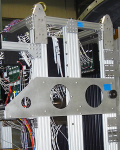Researchers have long thought that formation of insoluble fibrous “strings” of self-assembling proteins might be involved in the progression of a number of diseases, including neurodegenerative disorders such as Alzheimer’s and Parkinson’s. However, recent evidence suggests that aggregates that develop at an earlier stage than fibril formation, and accumulate in human organs, may be the primary toxic agents.
Insulin is a model protein to study Alzheimer’s, Parkinson’s, and more than 20 other diseases. A research team from Rensselaer Polytechnic Institute used small-angle neutron scattering (SANS) at the High-Flux Isotope Reactor at Oak Ridge National Laboratory to identify these early stage aggregates in insulin, called oligomers. The insulin can then be treated to remove them, a procedure critical to the usefulness of insulin to study neurodegenerative diseases.
Insulin is a small, well-folded protein that at low pH (1.6) and high temperature (65°C) is characterized by the accumulation of self assembling insoluble fibers, called amyloid fibrils. Insulin also forms these early stage fibrils when exposed to hydrophobic environments (e.g., air, materials like Teflon™). This creates a serious problem in insulin preparation and production: the aggregates get into the protein in solution, in the preparation stage and may lead to irreproducible in vitro results.
The Bio-SANS instrument was used to measure the accumulating insulin aggregates. The researchers were able to disassemble the fibrils and to demonstrate that a small fraction were toxic to neuronal cells.
No evidence of aggregate contamination was detected with other methods such as size exclusion chromatography, mass spectrometry, and gel electrophoresis. But Bio-SANS results revealed the existence of the potentially harmful microaggregates in the untreated insulin. To remove them, the researchers formulated two treatments: pH cycling, which raises and lowers the pH around the isoelectric point (pI) of the insulin molecule (the pI is the pH at which the molecule has no electrical charge). And diafiltration, a membrane-based separation used to reduce, remove, or exchange salts and other small molecule contaminants.
Diafiltration was used to remove small contaminants. Large contaminants were removed with a molecular weight cut-off membrane. Next, pH cycling was used to determine if the contaminants were insulin microaggregates. Cycling the insulin from pH 1.6 through the pI, where it precipitates, up to pH 8, where it is again soluble, exposes the insulin molecules to many different pH values that allow the protein microaggregates to dissolve.
Subsequent neutron scattering showed that after the treatment, the average size of the aggregates in the insulin samples was reduced to values closer to those previously predicted. It was then possible to create a more uniform solution, with kinetics of fibril formation from the native insulin protein that can be reproduced. This study can be used as a model of amyloid formation in other proteins, a step that is critical for studying the dynamics of fibril formation in neurological diseases such as Alzheimer’s and Parkinson’s.
These studies and others suggest that protein aggregation in insulin is mediated by hydrophobic interactions. The researchers attempted to identify the entity that was causing irreproducible amyloid fibrillation kinetics, and SANS was able to detect a change in the average size of particles in solution. Both methods (pH cycling and diafiltration) of removing aggregates in solution could apply to other proteins, such as those involved in the progression of Alzheimer’s disease.
The SANS work was sponsored by the Scientific User Facilities Division, Office of Basic Energy Sciences, U. S. Department of Energy.
The insulin was provided by Arne Staby, Novo Nordisk A/S; membranes were from Mike Phillips, Millipore Corporation; Stephen Evans assisted with the size exclusion chromatography; Dmitry Zagorevski assisted with the mass spectrometry; and Shuo Qian, Qui Zhang, and Sai Venkatesh Pingali at ORNL assisted with the SANS experiments.
Reference
: Caryn L. Heldt, Mirco Sorci, David Posada, Amir Hirsa, and Georges Belfort, “Detection and reduction of microaggregates in insulin preparations,” Biotechnology and Bioengineering, 108(1) 237–241 (January 1, 2011). DOI 10.1002/bit.22902. Published online August 17, 2010 Wiley Online Library (wileyonlinelibrary.com).





